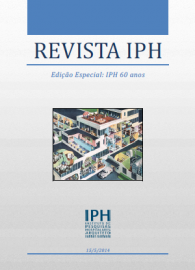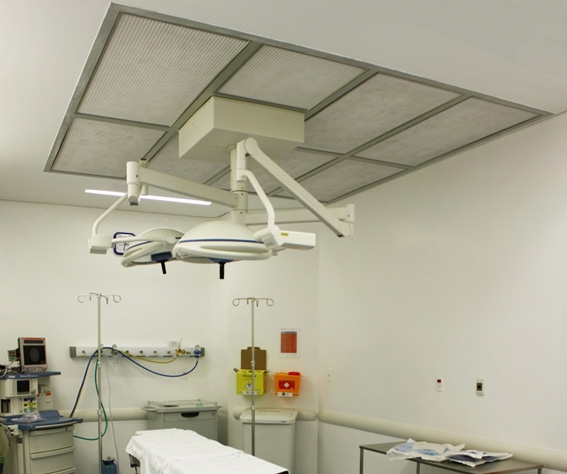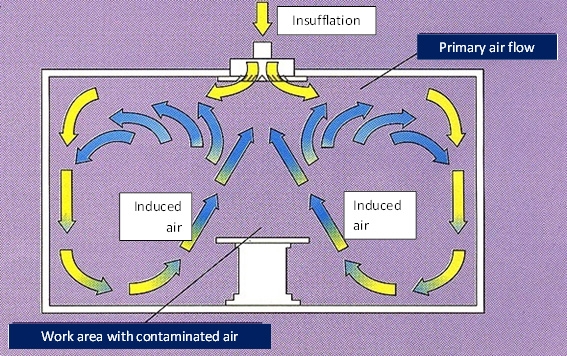Publications IPH Magazine Special: 60th Anniversary Surgical Centers: An Approach

- EDITORIAL
- Future Trends in Teaching and Research Hospital Design
- Jarbas Karman and the Hospital Architecture
- Surgical Centers: An Approach
- Acoustic Comfort In Healthcare Environments: Music, Landscape And Cladding Material As Humanizing Solutions
- Hospital Engineering and Maintenance: Committing To Maintaining Lives
- Communication and Leadership in Health Institutions
- The Relationship Between Professionals And Patients In The Health Sector - Tendencies And Perspectives
Surgical Centers: An Approach
Celso Simões Alexandre



There are many and varied treatments and recommendations in different countries concerning how to deal with the air-conditioning issue in Surgical Centers. In my point of view, three points deserve special attention:
- How to categorize the equipment?
- What kind of filters to use?
- How to distribute the air?
BRAZIL
The ABNT 7256 Brazilian regulation, under revision at the moment, classifies different hospital rooms according to the risk they offer regarding health damaging events originating from exposure to room air. And considering different rooms inside the surgical centers, the specialized surgery rooms (orthopedics, neurology, cardiology, transplant) come up as level 3, the others receiving a level 2 classification, including rooms destined to control biological and chemical agents.
The conditions of the levels of temperature (18 to 22°C) and relative dampness (RD) (45 to 55%) are the same for both kinds of room. There are differences in the filtering requirements, (G3+F8) for level 2 rooms and (G3+F7+A3) for level 3 rooms.
In what concerns air outflow, in both cases the regulation recommends 75m³/h re-circulated air - the number of times per hour the air goes into the machine to be treated, also known as the number of air exchanges - per m² of the room´s area - 15 of which are composed of outside air.
All rooms have positive pressure in relation to adjacent halls and rooms.
USA
In the United States the American Association of Heating, Refrigeration and Air-conditioning Engineers - ASHRAE - classifies rooms in three categories in their 2011 Handbook, Chapter 8:
Class A: rooms where minor complexity procedures take place, excluding pre-surgery sedation and IV, spinal or epidural procedures. Recommended temperature ranges from 21 to 24°C, and recommended relative dampness ranges between 30-60%, filtering with 2 stages MERV 7+MERV 14, 15 air exchanges per hour, from which 3 are from outside air. Positive pressure.
Class B: basically involves all other surgeries, the level 2 surgeries in Brazil, except the ones Brazilian regulation classifies as level 3. It is different from the category above in what concerns temperature - now ranging between 20-24ºC, and the air exchanges, which increase to 20, out of which 4 are from outside air.
Class C: corresponds to the Brazilian regulation concerning level 3 risk, with air outflow, temperature, dampness and pressurization degrees equal to class B´s. The big difference here is in the degree of filtering, which now requires 2 stages MERV7+HEPA, requiring that the HEPA filters not be in the machine, but rather in terminal units in the surgical center´s ceiling.
At the same time, and something not rare, there is another document with regulation status, ANSI/ASHRAE/ASHE Standard 170-2013, titled Ventilation of Health Care Facilities, which punctually mentions the 3 kinds of rooms, A, B e C, and decreases the minimally acceptable dampness level to 20%. The unofficial justification for the reduction is that in the northern hemisphere, keeping the dampness level above 30% would provoke the appearance of fungi between the external and internal protection of external walls, which in the midterm, would migrate to the internal layer. All other parameters remain valid.
Regarding air distribution, however, the standard 170 reads that the kinds of diffusers for A, B and C surgical rooms must be group E type, non-inhaling.
The traditional diffusers, 4-way type, belong to the inhaling type, once the air that goes out through the 4 sides of the diffuser after passing by the ceiling, and occasionally the walls, returns to the center of the diffuser. A lot of the so-called "dirt", contrary to common sense, is not dirt coming through the feeding ducts, but dirt coming from the environment, which is taken to the diffuser; and the black stain is, most of the times, a bio-film of micro-organisms.
Nowadays in Brazil we have non-inhaling high-induction diffusers, which throw the air down, with a small percentage going to the ceiling; but because they are of little or no use in the US, we understand they are not in the legislators´ minds, differently from the perforated plate diffuser with a kind of one-way flow (the former laminate).
What is curious (or dare we say wrong) is that the requirement for HEPA filters DOES NOT appear as a feature anymore, even in C surgical rooms. The 2 stages MERV 7 + MERV 14 mentioned above are advised. (That already appeared in the 170-2008 version of the norm.)
Curiously again, the ASHRAE STD 170 only mentions the HEPA filters requirement in isolation rooms.
Europe
Switzerland
Let us see what happens in Europe. Let us start by Switzerland, once it was the origin of the first Brazilian regulation for hospitals: a SWISS GUIDELINE SWKI- 99-3 (based on the DIN 1946, norm part 4 Germany).
It defines 2 kinds of rooms for surgical centers. A third class, III, applies to other hospital environments.
CLASS I: 10 UFC/m³ (one-way flow with terminal HEPA filter) and return of high and low air at 10.000m3/h.
CLASS II: 200 UFC/m³ with a subdivision:
CLASS II b: 50 UFC/m³ with segregated zone, support personnel outside the operation zone, one-way flow at 2000-3000m³/h, return as defined for CLASS I.
For 200 UFC/m³ terminal boxes with 2000-3000m3/h HEPA filter, turbulent flow, return as defined for CLASS I.
For both classes temperature ranging between 19 and 24°C, and relative dampness ranging between 45 and 55%.
CLASS III: 500 UFC/m³, no special requirements.
Germany
DIN 1946-4 norm
CLASS 1 Rooms:
Surgery rooms with one-way ventilation systems, covering all the area in which the surgery is taking place, including the instrument tables. There is a need for plates directing the lateral flow up to 2,1m above the floor.
- Minimum diffuser size: 2,8 x 2,8m.
- HEPA H14 Terminal Filters (now ISO 45H).
- Air outflow > 8000m³/h and outside air >1200 m³/h.
- Air speed 0,23 to 0,25 m/s (0,2 m/s as minimum).
- Temperature ranging from 19 to 26°C (adjustable).
- < 1 UFC in sedimentation plates of 50 cm2 surface and during 60 minutes IN OPERATION.
CLASS 1B Rooms:
- Surgery rooms with traditional turbulent flow.
- Temperature ranging from 19 to 26°C (adjustable).
- < 5 UFC in sedimentation plates of 50 cm2 surface during 60 minutes IN OPERATION.
RUSSIA
In the hospital environment 2 types of surgery rooms are defined: 1 and 3 (2 refer to intensive care); and this is the only norm consulted which tries to correlate clean rooms (general control of particles) and feasible particles.
CLASS 1 Rooms: for transplant, heart surgery, long surgeries, surgeries performed on patients having low immunity levels.
- ISO 5 and 5 UFC /m³ rooms.
- One-way flow.
- Temperature ranging between 18 and 24°C and minimum relative dampness at 30%.
CLASSE 3 Rooms: For other surgeries
- ISO 8 and 100 UFC/m³ rooms.
- Turbulent flow.
- Temperature ranging between 18 and 24°C.
- Minimum relative dampness at 30%.
Our standpoint is that the correlation between clean rooms (concern with total particles) and surgical centers (concern with feasible particles) is not as direct as the Russian regulation reads. On the other hand, we admit that it is much faster to obtain results with a particle counter or meter than to have sedimentation plates which afterwards have to be incubated before they lead to lab results.
Another issue is that we have been trying to establish an ?in operation? classification, and it is not acceptable to have a technician measuring that during a surgery for which Class 1 is advisable. Even if that were permitted, each case is a different case and different results would be obtained for the same room, depending on the number of people involved and their behavior (human beings are still the great polluters).
Back to the Beginning
What about Brazil? For lack of a definition, and considering it is much easier to count total particles, we dare propose the following values to the scientific community as a starting point for discussion, values specifically based on the kinds of filters and diffusers available in Brazil.
Class 1 Rooms - (< 10 UFC/m³ air) with one-way flow (former laminate) with minimum area of 2,8 x 2,8m and air directors up to 2,1m from the ground (metallic or plastic plates around the flow) and ISO 45H (H14) filters with diffuser termination in perforated plate (transplant, orthopedic, heart and long surgeries, and also surgeries on patients with low immunity levels), with checking done by air sampling. If sampling is carried out through sedimentation plate then the new limit would be < 1UFC (That would be equivalent to an ISO 5 clean room under the diffuser).

Note: In this room no flow directors were applied
Class 2 Rooms - (< 50 UFC/m3 air) with a one-way flow over the surgical table, with separated air curtain and ISO 45H filters with no less than 30 air exchanges per hour. For all other surgeries with total sedation, the ones in Class 1 excluded. (That would be equivalent to an ISO 6 room under the diffuser).

Class 3 Room - (< 200 UFC/ m³air) with turbulent flow, 35H filters, with at least 20 air exchanges per hour. For minor surgeries, ambulatory, aiming at an ISO 7 room, measuring preferably over surgical table.

Summing up, what we have presented here is only a personal opinion, and it could not have been different. It is only the beginning of a discussion in which surgeons and engineers may express their views, aiming to come to a definition concerning Brazil.
S.Paulo, February 2014
Celso Simões Alexandre
Electrotechnical Engineer (IST - Universidade Técnica de Lisboa)
References
ABNT 7256
RDC 50 ANVISA
ANSI/ASHRAE/ASHE Standard 170-2013
ASHRAE 2011 HVAC Applications Handbook Chapter 8
DIN NORM 1946-4 (Germany)
SWISS GUIDELINE SWKI- 99-3
NATIONAL STANDARD of the RUSSIAN FEDERATION (Air cleanliness in hospitals)
Related Content
Send by e-mail:



